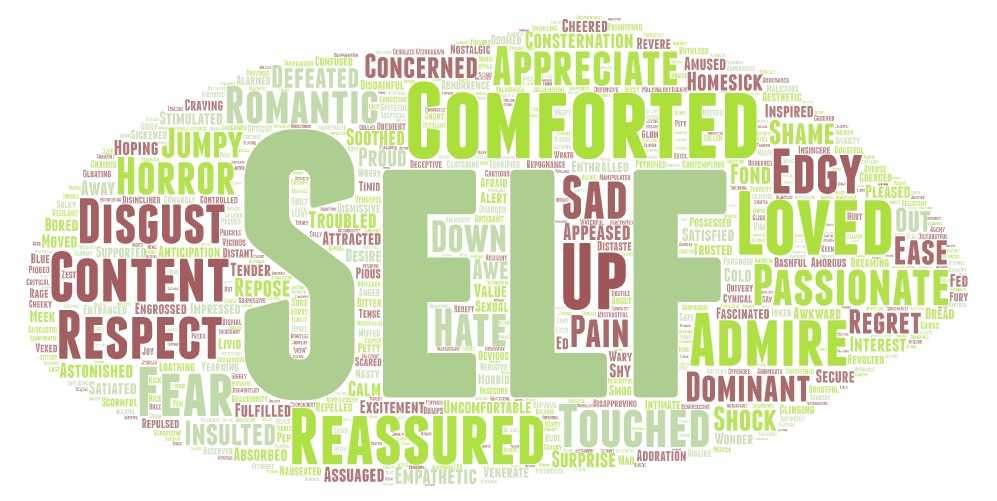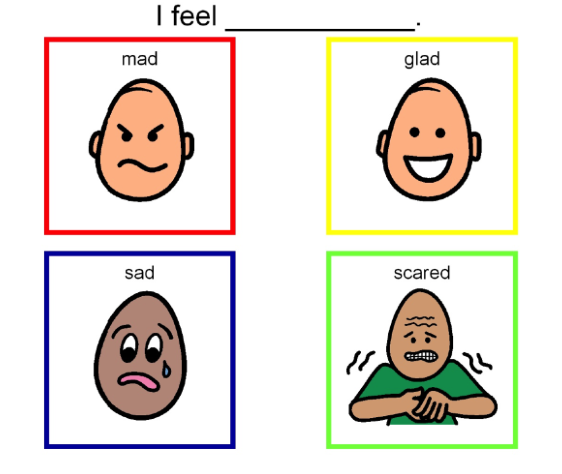Maybe you tried asking yourself ‘Am I mad, glad, sad, or scared?‘ and you drew a blank? Well, according to research at UC Berkeley, that might not be your fault. They don’t think there’s 4 emotions… they think there’s 27.
Me being an utter nerd, I got the Berkeley researchers’ list of emotions … grouped them as they tend to occur together … and then added synonyms & associated words.
Here’s the result: my master list of around 700 emotions. If you can’t figure out what you’re feeling, try reading through this list and see if any words here strike a chord.
1. disgust: abhorrence, contemptous, disapproving, disdainful, disgust, dismissive, distaste, loathing, nauseated, repelled, repugnance, repulsed, revolted, scornful, sickened
2. horror: doomed, dread, horror, petrified, terrified
3. fear: afraid, alarmed, alert, avoidant, bashful, boastful, clinging, clutching, coerced, cold, controlled, cowardly, cynical, deceptive, derisive, devious, disinclined, distant, distrustful, dominant, dominated, doubtful, edgy, fear, frightened, gloating, grandiosity, guarded, insecure, insincere, judgemental, jumpy, malevolent, malicious, manipulated, meek, mistrustful, morbid, nasty, obedient, paranoid, pessimistic, pious, quivery, reluctant, reserved, ruthless, sarcastic, scared, sceptical, self-conscious, shy, smug, spiteful, submissive, suspicious, tense, threatened, timid, unnerved, unwilling, uptight, vengeful, vicious , vigilant, vulnerable, wary, watchful, withdrawn
4. anxiety: angst, anxious, apprehensive, cautious, concerned, consternation, hesitant, jumpy, nervous, trepidation, worry
5. anger: abominate, aggravated, aggressive, angry, animosity, annoyance, antipathy, averse, bitter, bothered, cheeky, critical, cross, defensive, disgruntled, dislike, displeasure, ennervated, exasperated, fed up, ferocity, frustrated, fury, grouchy, hate, hatred, hostile, impertinent, indignant, insulted, insulting, irked, irritated, livid, mad, miffed, offended, outraged, peeved, petty, petulant, piqued, prickly, provoked, quarrelsome, rage, rattled, reproachful, resentful, rude, sulky, sullen, vexed, wrath,
6. sadness: bereft, blue, chagrined, crestfallen, crushed, defeated, dejected, depressed, desolate, despair, despondent, disappointment, disconsolate, disenchanted, disillusioned, dismal, doleful, down, down in the dumps, forlorn, gloomy, glum, grief, heartbroken, homesick, melancholy, miserable, mopey, morose, mournful, regret, sad, sorrowful, sympathetic, teary, unhappy, weepy, woebegone
7. pain: abandoned, aching, afflicted, agitated, agony, alienated, anguish, apologetic, cantankerous, contrite, cranky, culpable, defeated, disconnected, discontent, discouraged, dissatisfied, distraught, distressed, empathetic pain, grumpy, guilt, hateful, hurt, hysterical, ignorant, inadequate, inferior, isolated, lonely, naive, needy, neglected, perturbed, regret, rejection, remorseful, shame, shock, smarting, sore, sorry, suffering, throbbing, tormented, tortured, troubled, unappreciated, uncomfortable, unsupported, unworthy, upset, wretched
8. surprise: astonished, astounded, bombshell, disbelief, dismay, dumbstruck, flabbergasted, flustered, revelation, shock, startled, stunned, surprised, thunderbolt, ‘wow’-ed
9. relief, abated, allayed, alleviated, “a narrow escape”, appeased, assuaged, comforted, completed, consoled, delivance, discharged, dulled, eased, exemption, finished, freed, lessened, liberated, mitigated, processed, reassured, reduced, released, relieved, repose, safe, solace, soothed, succour
10. excitement: anticipation, edgy, excitement, hyper, intensity, jittery, manic, pep, restless, stimulated, thrilled, vim, wanderlust, zest
11. interest: absorbed, allure, anticipation, appeal, attentive, attraction, charmed, compulsive, curious, eager, engrossed, enthralled, enthusiastic, expectant, fascinated, focused, immersed, inquisitive, inspired, interest, introspective, involved, keen, meditative, obsessed, passionate, pensive, reflective, seduced, tempted, zealous
12. satisfied: appeased, assuaged, content, eureka!, fulfilled, gratified, pleased, proud, satiated, satisfied, triumph, victorious
13. awkward: awkward, cumbersome, cumbrous, difficult, embarrassment, fiddly, humiliation, inappropriate, inconvenient, inopportune, lumbersome, mortified, shame, silly, tricky, uncomfortable, unfortunate, unpleasant, unsteady, unwieldy
14. amused: amused, cheered, diverted, engaged, enlivened, entertained, funny, giggly, humorous, in convulsions, jocular, laughter, mirth, mischievous, naughty, playful, regaled, smiling, tickled, whimsical, witty, zany
15. joy: aligned, authentic, blissed-out, buoyant, buzz, carefree, cheerful, click, content, creative, deliciously lazy, delighted, ebullient, ecstatic, elated, enlightened, euphoric, exuberant, exultation, fulfilled, gay, glad, glee, grateful, happy, harmonious, hopeful, jovial, joyful, jubilation, kick, lighthearted, nice, pleased, pleasure, rapture, rejoicing, thankful, upbeat, uplifted, vivacious
16. adoration: adoration, affable, affection, agreeable, altruistic, attached, caring, charitable, comforted, comforting, compassionate, concerned, connected, considerate, cooperative, devoted, empathetic, fond, friendly, hospitable, kind, liking, lovable, loved, loving, pity, reassured, reassuring, secure, self-compassion, sociable, supported, supportive, tender, thoughtful, trusted, valued, warm
17. admiration: acclaim, accolade, admiration, adulate, amazed, applause, appreciate, approve, bowled over, blown away, compliment, esteem, exalt, extol, impressed, laud, plaudit, praise, proud, regard, respect, touched, tribute, venerate
18. awe: astonishment, awe, honour, idolise, impressed, inspired, lionise, moved, respect, revere, reverent, venerate, wonder, worship, , 19. aesthetic appreciation, attend, notice, note, value, respect, prize, cherish, treasure, admire, comprehend, perceive, sense, aesthetic appreciation, touched, moved, wonder
20. craving: aspiring to, broody, covetous, craving, desire, dreaming of, envious, greedy for, hankering after, have a yen for, hoping for, hungry, impatient, infatuated, jealous, longing, malnourished, pining, possessive, rivalrous, sated, satiated, seeking, thirsty, undernourished, wanting, wishing, yearning
21. calm: at ease, calm, certain, chilled out, complacent, composed, content, equanimity, fatalistic, free, loose, mollified, nonchalant, nurtured, pacific, pacified, peaceful, philosophical, placated, placid, quiet, reasoned, relaxed, repose, resigned, self-possessed, secure, serene, soothed, still, sure, tranquil, trusting, unruffled
22. entranced: absorbed, beguiled, bewitched, captivated, carried away, engrossed, enraptured, enthralled, entranced, fascinated, gripped, hypnotised, intrigued, mesmerised, riveted, spellbound, touched
23. confused: addled, baffled, befuddled, bemused, bewildered, chaotic, clueless, conflicted, confused, consternation, demented, disoriented, jumbled, lost, mixed up, muddled, nonplussed, puzzled, stuck, torn, troubled, uncertainty, unclear, undecided, uneasy, unsure, volatile
24. bored: absent, ambivalent, apathetic, blasé, bored, careless, detached, disengaged, disinterested, distracted, ennui, inattentive, indifferent, jaded, lacklustre, lax, listless, monotonous, mundane, palled on, passive, preoccupied, rash, reckless, spiritless, stultified, stupefied, tedious, unmotivated, vacant
25. nostalgic: bittersweet, emotional, evocative, homesick, maudlin, nostalgic, reminiscing, romantic, sentimental, wisful, yearning
26. romantic, affectionate, amorous, doting, dreaming, enamoured, fantasizing, fond, intimate, lovey-dovey, loving, mushy, passionate, romantic, tender-hearted, visioning
27. sexual desire: amatory, amorous, ardent, aroused, attracted, carnal, erotic, horny, hot, impassioned, intimate, lustful, passionate, randy, sensual, sensuous, sexual, stimulated, sportive, turned on
—
If you or someone you know is in crisis and needs help, contact Samaritans (Ireland and Northern Ireland) on 116 123 or Lifeline (Northern Ireland) on 0808 808 8000.
—
References:
Emma MacAdam, Licensed Marriage and Family Therapist
https://news.berkeley.edu/2017/09/06/27-emotions/
Oxford English Dictionary






























